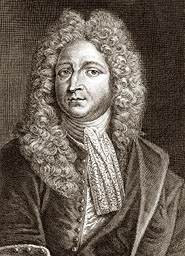
The Scottish financier and adventurer John Law, who was also an authority on banking and the circulation of money, convinced the regent, Philippe d'Orléans, that he could liquidate the government's debt by a system of credit founded on paper money. In 1716 he launched the Banque générale. The following year he founded the Company of the West, the capital for which was raised by the sale of 500-livre shares, payable only in government notes. The first shares were called "mothers," then, aided by the initial success, came the "daughters" and the "granddaughters."
Law created extraordinary enthusiasm for his scheme using advertisements and public relations--presenting the Mississippi as a land of plenty. In return for obtaining the trade monopoly for Louisiana, the Company had to assure the colony's defense--upkeep of fortifications and troops, and gifts to Indians--and to transport 6,000 colonists and 3,000 African slaves in 25 years. In 1719, the Company of the West annexed several other overseas firms (the Senegal, East Indies and China companies, for example) to create the Company of the Indies. But the over-issuing of bank notes weakened confidence and the system crumbled. Ruined, Law fled to Brussels in December 1720. His impact, via the Company of the West, nevertheless gave Louisiana its demographic base.
Associated documents :
- This portrait dates from 1719-20 and presents John Law at the height of his glory and power. By this time, he had accumulated the titles and functions of conseiller du roi, Controller General of Finances, and Inspector General of the two institutions created at his initiative: the banque générale (1716) and the Company of the Indies (formerly the Company of the West) which was, from 1717, responsible for the development of Louisiana.
- This small, bilingual (French-English) volume was published in London during 1720, just before the collapse of John Law's "system." It underscored the spectacular rise of the Company of the West and the impact of its actions on the entire French economy. The work also included a description of the "Mississippi Country" and an account of the first discoveries made there.
- This caricature from 1721, centered on the portrait of "messire Quinquenpoix" (alias John Law), satirized the creator of the banque générale and France's first paper money. At the end of 1720, with the issuance of over-inflated bank notes, "Law's system" collapsed and its author fled to Bruxelles.